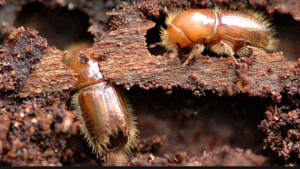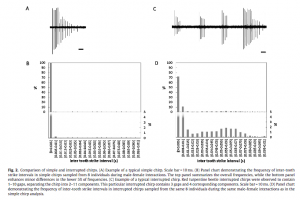
Bark beetles (Scolytinae)
The process of finding a mate is not fully understood in a lot of animals. Some animals use olfaction, while others use mating calls. Close-range courtship signals are thought to be the most influential type of acoustic signal for mating decisions in insects. These courtship songs occur once males and females are nearby each other and vary greatly. The varying song infers that they are condition-dependent and can convey information about mate quality. An unanswered question that scientists have is how potential mates are differentiated by their courtship signal characteristics. This study investigated acoustic courtship behaviors in bark beetles (Scolytinae). They hypothesized that acoustic signals are honest indicators of male condition and that females choose males based on signal characteristics.
Male bark beetles have two distinct types of chirps. They found that simple and uninterrupted chirps were distinct from one another in many ways (Figu re 2). The majority of bark beetles produced both simple and uninterrupted chirps. The ratio of the types of chirps varied at different stages of an encounter. Larger males were found to produce chirps at a significantly higher rate and also had a significantly larger portion of their chirps being interrupted. However, not all males produced interrupted chirps during courtship. Males that produced interrupted chirps had an easier time at entry. Females accepted 100% of males that produced interrupted chirps while rejecting males that produced only simple chirps.
re 2). The majority of bark beetles produced both simple and uninterrupted chirps. The ratio of the types of chirps varied at different stages of an encounter. Larger males were found to produce chirps at a significantly higher rate and also had a significantly larger portion of their chirps being interrupted. However, not all males produced interrupted chirps during courtship. Males that produced interrupted chirps had an easier time at entry. Females accepted 100% of males that produced interrupted chirps while rejecting males that produced only simple chirps.
Females showed a significant preference for males who produced interrupted chirps, which confirms the hypothesis that females distinguish between males on the basis of their chirp performances. They suggest that interrupted chirps during courtship advertise a male’s size and motor skills. Therefore, it functions as a ‘password’ that allows a male to enter a female’s. Based off of the data from Figure 2, they suggest that males are capable of producing long simple chirps but do not. Future studies should be done on how and why males produce these complex and diverse courtship songs.
The significance of these results is up for debate. Muting experiments found evidence that these signals are crucial to mating. Muted beetles had a significantly reduced chance of successful mating. However, the specific function of the courtship behaviors are still not fully understood and more research needs to be done. The results confirm that bark beetles show a preference for courtship songs. Further research should be done to determine what sensory systems these beetles are using to communicate in this way.
Reference: Lindeman, A., Yack, J. E. (2015). What is the password? Female bark beetles (Scolytinae) grant males access to their galleries based on courtship song, Behavioural Processes, Volume 115 Pages 123-131.
